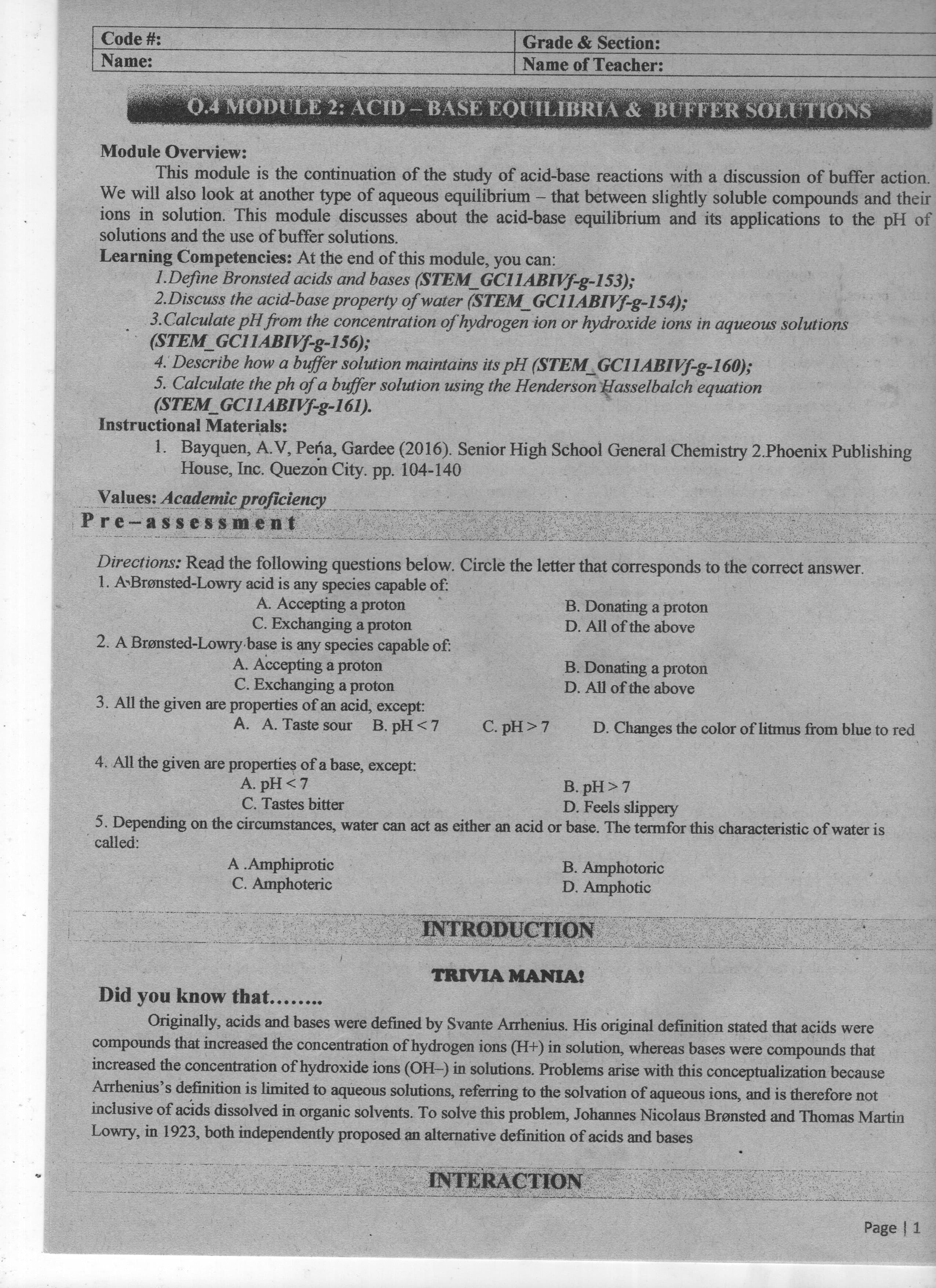Principles of Modern Chemistry
8th Edition
ISBN:9781305079113
Author:David W. Oxtoby, H. Pat Gillis, Laurie J. Butler
Publisher:David W. Oxtoby, H. Pat Gillis, Laurie J. Butler
Chapter20: Molecular Spectroscopy And Photochemistry
Section: Chapter Questions
Problem 67CP
Related questions
Question
100%
MULTIPLE CHOICE NUMBERS 1-5

Transcribed Image Text:Code #:
Grade & Section:
Name:
Name of Teacher:
0.4 MODULE 2: ACID- BASE EQUILIBRIA & BUFFER SOLUTIONS
Module Overview:
This module is the continuation of the study of acid-base reactions with a discussion of buffer action.
We will also look at another type of aqueous equilibrium - that between slightly soluble compounds and their
ions in solution. This module discusses about the acid-base equilibrium and its applications to the pH of
solutions and the use of buffer solutions.
Learning Competencies: At the end of this module, you can:
1.Define Bronsted acids and bases (STEM_GC11ABIVS-g-153);
2.Discuss the acid-base property of water (STEM_GC11ABIVJ-g-154);
3.Calculate pH from the concentration of hydrogen ion or hydroxide ions in aqueous solutions
(STEM_GC11ABIVJ-g-156);
4. Describe how a buffer solution maintains its pH (STEM GC11ABIVS-g-160)3;
5. Calculate the ph of a buffer solution using the Henderson Hasselbalch equation
(STEM_GC11ABIVJ-g-161).
Instructional Materials:
1. Bayquen, A. V, Pena, Gardee (2016). Senior High School General Chemistry 2.Phoenix Publishing
House, Inc. Quezon City. pp. 104-140
Values: Academic proficiency
Pre-assessment
Directions: Read the following questions below. Circle the letter that corresponds to the correct answer.
1. A-Brønsted-Lowry acid is any species capable of:
A. Accepting a proton
C. Exchanging a proton
2. A Brønsted-Lowry base is any species capable of:
A. Accepting a proton
C. Exchanging a proton
3. All the given are properties of an acid, except:
B. pH <7
B. Donating a proton
D. All of the above
B. Donating a proton
D. All of the above
C. pH >7
D. Changes the color of litmus from blue to red
A. A. Taste sour
4. All the given are properties of a base, except:
L> Hd
C. Tastes bitter
B. pH>7
D. Feels slippery
5. Depending on the circumstances, water can act as either an acid or base. The termfor this characteristic of water is
called:
A .Amphiprotic
C. Amphoteric
B. Amphotoric
D. Amphotic
INTRODUCTION
TRIVIA MANIA!
Did
you know that...
Originally, acids and bases were defined by Svante Arrhenius. His original definition stated that acids were
compounds that increased the concentration of hydrogen ions (H+) in solution, whereas bases were compounds that
increased the concentration of hydroxide ions (OH-) in solutions. Problems arise with this conceptualization because
Arrhenius's definition is limited to aqueous solutions, referring to the solvation of aqueous ions, and is therefore not
inclusive of acids dissolved in organic solvents. To solve this problem, Johannes Nicolaus Brønsted and Thomas Martin
Lowry, in 1923, both independently proposed an alternative definition of acids and bases
INTERACTION
Page | 1
Expert Solution
This question has been solved!
Explore an expertly crafted, step-by-step solution for a thorough understanding of key concepts.
Step by step
Solved in 2 steps

Knowledge Booster
Learn more about
Need a deep-dive on the concept behind this application? Look no further. Learn more about this topic, chemistry and related others by exploring similar questions and additional content below.Recommended textbooks for you

Principles of Modern Chemistry
Chemistry
ISBN:
9781305079113
Author:
David W. Oxtoby, H. Pat Gillis, Laurie J. Butler
Publisher:
Cengage Learning


Chemistry: An Atoms First Approach
Chemistry
ISBN:
9781305079243
Author:
Steven S. Zumdahl, Susan A. Zumdahl
Publisher:
Cengage Learning

Principles of Modern Chemistry
Chemistry
ISBN:
9781305079113
Author:
David W. Oxtoby, H. Pat Gillis, Laurie J. Butler
Publisher:
Cengage Learning


Chemistry: An Atoms First Approach
Chemistry
ISBN:
9781305079243
Author:
Steven S. Zumdahl, Susan A. Zumdahl
Publisher:
Cengage Learning

Chemistry
Chemistry
ISBN:
9781305957404
Author:
Steven S. Zumdahl, Susan A. Zumdahl, Donald J. DeCoste
Publisher:
Cengage Learning